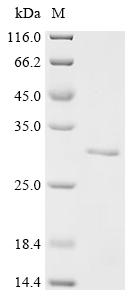Recombinant Salmo salar Prolactin is produced in E.coli and contains the complete mature protein sequence, spanning amino acids 24 to 210. The product includes a C-terminal 6xHis-tag that simplifies purification and detection processes. SDS-PAGE analysis confirms purity levels above 90%, making it well-suited for research applications that demand high-quality protein standards and consistent results.
Prolactin appears to be a hormone with well-established roles in fish growth and development, particularly in osmoregulation and reproductive functions. Research on endocrine mechanisms and physiological adaptations in aquatic species often relies on this hormone to understand how environmental factors may influence hormone-driven processes.
Potential Applications
Note: The applications listed below are based on what we know about this protein's biological functions, published research, and experience from experts in the field. However, we haven't fully tested all of these applications ourselves yet. We'd recommend running some preliminary tests first to make sure they work for your specific research goals.
Prolactin is a complex four-helix bundle hormone requiring specific disulfide bonds and tertiary structure for receptor binding and bioactivity. E. coli lacks eukaryotic chaperones and oxidative folding machinery, making correct disulfide bond formation unlikely. The C-terminal His tag may not directly interfere with folding, but it cannot compensate for fundamental limitations. Without experimental validation (e.g., receptor binding or cell-based activity assays), this protein is highly likely to be misfolded and inactive.
1. Comparative Endocrinology Studies
This application requires confirmed bioactivity. If misfolded, competitive binding assays will yield inaccurate cross-species affinity data. First, validate receptor binding using salmon prolactin receptors (e.g., via SPR). If properly folded, this recombinant Salmo salar prolactin could serve as a reference standard when examining prolactin structure and function across various fish species. Without activity, evolutionary comparisons are invalid.
2. Antibody Development and Validation
This recombinant prolactin is suitable for generating antibodies against linear epitopes. The His tag facilitates purification and immobilization for screening. However, antibodies may not recognize conformational epitopes of native prolactin. Validate against pituitary-derived salmon prolactin for physiological relevance.
3. Protein-Protein Interaction Studies
His-tag enables pull-down assays, but misfolding may cause non-physiological interactions (e.g., false positives with non-native partners). Validate any interactions using co-immunoprecipitation with native prolactin from salmon tissues.
4. Biochemical Characterization and Stability Studies
Applicable for basic biophysical analysis (e.g., CD spectroscopy for helical content, DLS for aggregation). However, data reflect E. coli-derived protein properties, not native prolactin. Do not extrapolate stability results to physiological contexts.
Final Recommendation & Action Plan
Validate bioactivity before functional use. Perform receptor binding assays (e.g., with salmon prolactin receptor-expressing cells) or cell proliferation tests (e.g., Nb2 rat lymphoma bioassay). If active, proceed with comparative/interaction studies; if inactive, limit to antibody production with validation against native prolactin. For reliable results, express prolactin in eukaryotic systems (e.g., yeast/mammalian cells) to ensure proper folding. Always include native prolactin controls to confirm biological relevance.






